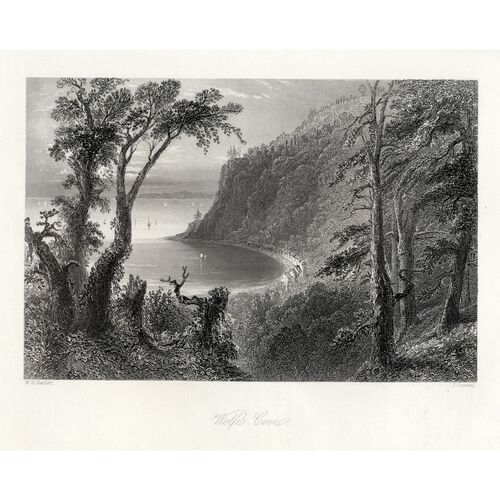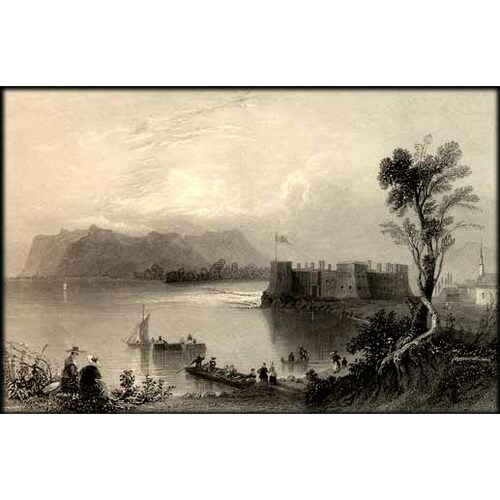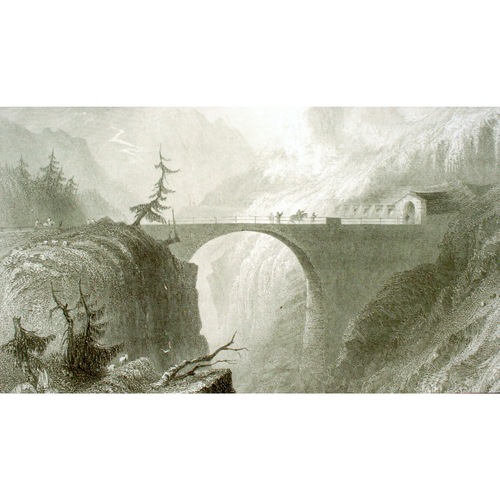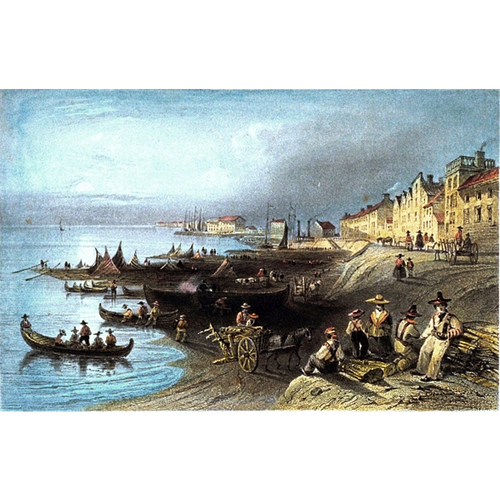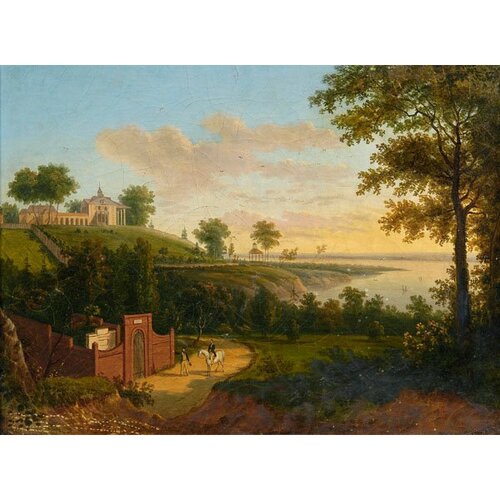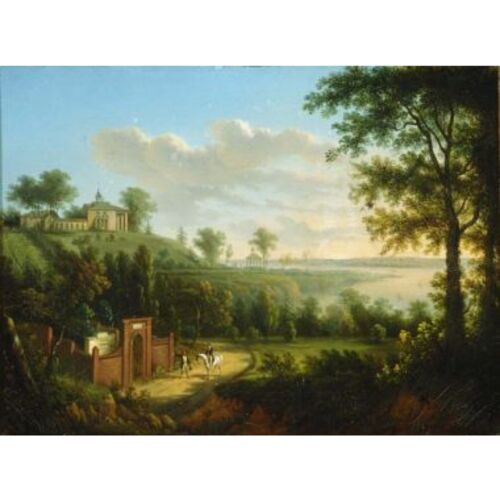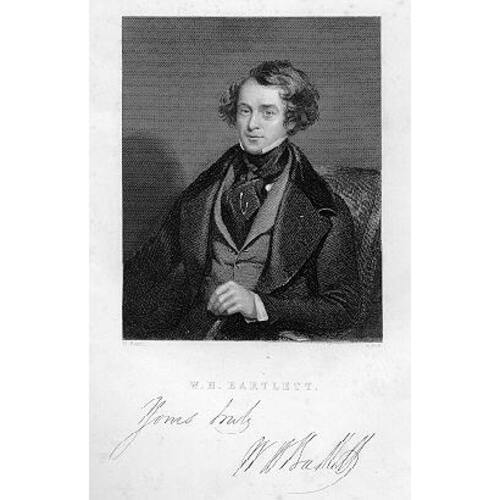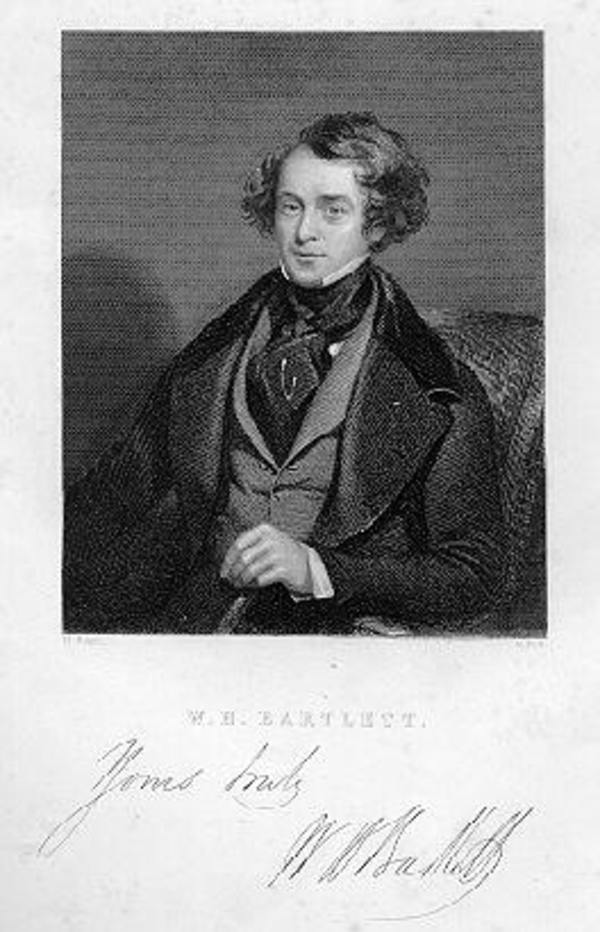
Source: Courtesy of Wikimedia Commons
BARTLETT, WILLIAM HENRY, illustrator; b. 26 March 1809 in Kentish Town (London), second son of William and Ann Bartlett; d. 13 Sept. 1854 off Malta and was buried at sea.
William Henry Bartlett, the son of middle-class parents, attended a boarding-school in London from 1816 to 1821 and in 1822 was apprenticed to the architect and antiquarian, John Britton, whose establishment in the parish of St Pancras (London) offered the boy an education that was both theoretical and practical. Bartlett studied and copied architectural drawings of the past and present and, with Britton, visited noted ruins in England from which he made detailed sketches to be engraved for some of Britton’s own publications. At first these sketches were purely architectural, as drawings in the last volume of Britton’s five-volume The architectural antiquities of Great Britain (London, 1807–26) attest. Later, the quality of Bartlett’s sketches and his interest in landscape, especially obvious in some of the water-colours which he did about 1825 of Thomas Hope’s home at Deepdene, Surrey, led Britton to undertake publication of Picturesque antiquities of the English cities (London, 1836).
Bartlett continued to work for Britton as a journeyman after his apprenticeship ended in 1829, although he also provided sketches for other London publishers. On 6 July 1831 he married Susanna Moon and thereafter his career was increasingly directed towards providing a livelihood for himself, his wife, and their five children. One of his first major assignments was to supply illustrations for Dr William Beattie’s Switzerland illustrated (London, 1836), published by George Virtue. He sent 108 sketches in pen, pencil, and sepia wash to engravers who had been trained by the artist Turner, and they etched them on steel plates for Virtue. The thousands of prints made from these plates are proof of Bartlett’s success in catering to the popular taste for picturesque landscape and the sublimity of mountain scenery. For the rest of his life Bartlett’s travels were extensive and continuous, and they led to illustrations for works on Syria, the Holy Land and Asia Minor, the Mediterranean coast, northern Italy, the Netherlands and Belgium, Scotland, Ireland, the coastal areas of Britain, the Bosphorus, the Danube, the United States, and Canada. Bartlett became an accomplished traveller.
According to Britton and Beattie, Bartlett visited North America four times: 1836–37, 1838, 1841, and 1852. From the summer of 1836 to July 1837 he was in the United States acquiring illustrations for Nathaniel Parker Willis’s American scenery (1840), and in the summer and autumn of 1838 he was in the Canadas sketching for Willis’s Canadian scenery illustrated (1842) .
Although little is known about Bartlett’s itinerary in North America, a map in American scenery suggests that his travels during 1836–37 began in New York City and took him north to the White Mountains, N.H., west to Niagara Falls, N.Y., and south to Washington, D.C. His itinerary in the Canadas in 1838 and the observations he may have made also remain obscure because none of his letters from this period has been found. His route appears on a map in Canadian scenery illustrated: he seems to have travelled from Quebec City westward to Niagara Falls, and then by way of the Erie Canal to visit Willis at Owego, N.Y., before sailing for England in December 1838. No written record survives of Bartlett’s visit to the Maritimes. The dates of the engravings in Canadian scenery illustrated seem to indicate that he went there in 1841 after another visit to the United States.
Willis’s texts for the two volumes are undistinguished, a major portion of the book on British North America having been drawn from the works of authors such as Pierre-François-Xavier de Charlevoix*, George Heriot*, James Pattison Cockburn*, and Catharine Parr Traill [Strickland*]. However, the five-by-seven-inch sepia sketches which Bartlett provided have remained popular. Their popularity owes much to Bartlett’s attention to architectural detail as a result of his training in England, to his experiences during his travels, and to his own penchant for the picturesque and sublime in landscape. His was an art which appealed to viewers content to be passive spectators of engravings of scenes easily recognizable from their own experience or reading. It was an art which, reflecting the theories of William Gilpin and Edmund Burke, emphasized the irregular and rough, light and shadow, ruined buildings and vast mountains, wild river reaches and towering crags.
Above all, Bartlett’s landscapes were readily identifiable. All but 6 of the 120 engravings in Canadian scenery illustrated have a specific geographic location. As a result, Bartlett’s sketches have considerable historical value, for they depict the country and its people as they appeared in 1838 to one with an eye for the picturesque. Nearly 100 of the engravings show rivers, lakes, rapids, and waterfalls, and many of them capture the daily life of the Canadian people: the growth of settlement; the presence of British army units; travel by canoes, sailing boats, and early steamships; the timber trade with rafts on the Ottawa River; mills on the Rideau River and at Sherbrooke, Lower Canada; fish markets and waterfronts; the excavation for the Cornwall Canal; and, especially, the homes of the people, from the pioneer log shanty in Upper Canada to Judge Thomas Chandler Haliburton*’s comfortable frame bungalow in Windsor, N.S. As with Canadian scenery illustrated, Bartlett’s sketches had ensured the popularity of American scenery. The illustrations in the latter are similar in style; their content, distinctively American, shows the economic advance of the eastern United States over Upper and Lower Canada.
Bartlett was both author and illustrator of numerous other works, including two books about the United States for which he undertook a fourth visit to North America in 1852. The Pilgrim Fathers (1853) contains steel engravings and woodcuts, and The history of the United States (1856), completed by Bernard Bolingbroke Woodward after Bartlett’s death, has 31 steel engravings, all of which had appeared in Canadian scenery illustrated or American scenery. The first of these works is more scholarly, containing original chronicles of the Pilgrims. Bartlett’s contribution to the second is an elementary textbook which pays scant attention to identification of source material or analysis of cause and result. His own travels in America, however, enabled him to describe locations with facility and to sustain a realistic narrative. His prose is workmanlike and often effective, demonstrating the effects of his employment from 1849 to 1852 as editor of Sharpe’s London Magazine. He continued to accept commissions for illustrations from his London publishers and died during his return from a sketching trip in Turkey and Greece, probably of cholera.
William Henry Bartlett was a warm-hearted, sensitive, rather reserved Englishman who was devoted to his family and to a small number of intimate friends among whom was his biographer, William Beattie. Because he was willing to subordinate his artistic talent to the needs of his major publisher, George Virtue, and to the contemporary taste for picturesque topographical illustration, Bartlett failed to achieve significant standing as an artist. Consequently his art seems inferior when compared with the best work of Cockburn, Heriot, or James D. Duncan*. But his skill in sketching architectural detail, his love for picturesque landscape, and his interest in the life of the people of Canada gave to his illustrations in Canadian scenery illustrated – and also in American scenery – a historical importance that merits their survival.
[William Henry Bartlett’s drawings are housed at the PAC, Art Gallery of Ontario (Toronto), National Gallery of Canada (Ottawa), McLaughlin Library, Univ. of Guelph (Guelph, Ont.), and in England at the British Museum (London), Minet Library (London), Northampton Public Library (Northampton), and Victoria and Albert Museum (London). Engravings done from his drawings depicting North American scenes were published in N. P. Willis, American scenery; or land, lake and river illustrations of transatlantic nature, from drawings by W. H. Bartlett . . . (2v., London, 1840) and in Canadian scenery illustrated, from drawings by W. H. Bartlett (2v., London, 1842; repr. Toronto, 1967). Bartlett himself wrote and illustrated 12 books, including The Pilgrim Fathers; or, the founders of New England in the reign of James the First (London, 1853), as well as the first three sections of the first volume of The history of the United States of North America; from the discovery of the western world to the present day (3v., New York, [1855–56]), the remaining sections of which were completed by Bernard Bolingbroke Woodward. A full list of the books written or illustrated by Bartlett can be found in A. M. Ross, William Henry Bartlett, artist, author, and traveller . . . (Toronto, 1973), which also republishes the biography of the artist written by his contemporary, William Beattie, Brief memoir of the late William Henry Bartlett . . . (London, 1855). a.m.r.]
John Britton, The autobiography of John Britton . . . (3v., London, 1849–50). DNB. Harper, Early painters and engravers. Michel Brunet et J. R. Harper, Québec 1800, W. H. Bartlett: un essai de gravures romantiques sur le pays du Québec au XIXe siècle ([Montréal], 1968). Gérard Morisset, Peintres et tableaux (Québec, 1936). Janice Tyrwhitt, Bartlett’s Canada; a pre-confederation journey, intro. H. C. Campbell (Toronto, 1968). John Britton, “Mr. William Henry Bartlett,” Art-Journal (London and New York), 1 (1855): 24–26.
Cite This Article
Alexander M. Ross, “BARTLETT, WILLIAM HENRY,” in Dictionary of Canadian Biography, vol. 8, University of Toronto/Université Laval, 2003–, accessed April 17, 2025, https://www.biographi.ca/en/bio/bartlett_william_henry_8E.html.
The citation above shows the format for footnotes and endnotes according to the Chicago manual of style (16th edition). Information to be used in other citation formats:
| Permalink: | https://www.biographi.ca/en/bio/bartlett_william_henry_8E.html |
| Author of Article: | Alexander M. Ross |
| Title of Article: | BARTLETT, WILLIAM HENRY |
| Publication Name: | Dictionary of Canadian Biography, vol. 8 |
| Publisher: | University of Toronto/Université Laval |
| Year of revision: | 1985 |
| Access Date: | April 17, 2025 |


